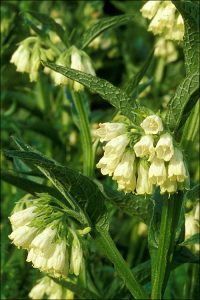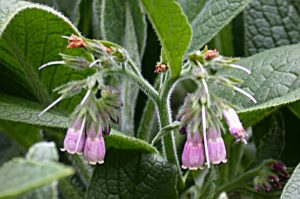Comfrey
Get all the latest from Natural Health Techniques delivered directly to your inbox when you join our newsletter here.
Stay in touch:
Sign up for occasional updates/videos/tips/specials and receive the Fast-Start Bonus Report with or 150 Tips and Tricks to optimize your health today!
Comfrey
(Symphytum officinale)
- Alias names for Comfrey: Comphrey, Knitbone, Knitback, Consound, Blackwort, Bruisewort, Slippery Root, Boneset, Yalluc (Saxon), Gum Plant, Consolid, Ass Fur, Healherb, All Heal, Wound Wort.
- Chinese Name for Comfrey: None Found
Comfrey pictures:
- Picture References listed under Helpful Links Section.
About Comfrey: Comfrey is perennial plant which can grow up to 3 feet tall. Comfrey has thick rough prickly leaves and bell-like flowers that can vary from white, pink, and mauve in color. The Comfrey plant is often confused with Foxglove which is toxic if consumed. While Knitbone originated in Europe, Comfrey now grows in all parts of the world. Comfrey prefers moist and marshy areas that are in the sun or partial shade. In order to grow Comfrey, you may choose to plant seeds in the spring or divide roots in the fall. The leaves and flowers are harvested during summer months, and the root may be dug in the fall.
Actions and Uses of Comfrey:
- Acne
- Aids virus
- Allergies
- Anemia
- Anti-inflammatory
- Asthma
- Astringent
- Bladder
- Boils
- Bruises
- Cancer
- Colds/flue
- Demulcent
- Eyes (Blepharitis/eyelid inflammation, Conjunctivitis, Pinkeye
- Fatigue
- Fractures/broken bones
- Gout
- Heals wounds and bones
- Insect bites
- Irritable bowel syndrome
- Joints/Arthritis
- Kidney stones
- Leg cramps
- Respiratory conditions (Bronchitis, Cough, Pleurisy, Sinusitis, Tuberculosis)
- Scars
- Skin (Eczema, Fungal infection, Psoriasis, Rashes and Ulcers
- Stomach ulcers/peptic ulcers
- Thrombophlebitis
How Comfrey is used and how it works:
Comfrey contains allantoin which is a cell-proliferant which helps repair damaged tissue. It promotes the knitting together of bones and ligaments. The herb also contains rosmarinic acid which is an anti-inflammatory property.
- Comfrey oil or ointment as topical treatment for skin conditions such as acne, boils and psoriasis.
- Comfrey compresses may be applied to speed the healing of bruises and sprains.
- Infused Oil can be applied to sprains.
- A poultice made of chopped leaves is applied to boils.
- Root tincture is used to treat acne.
Parts of the Comfrey plant used: Aerial parts/leaves & flowers, roots
Properties of Comfrey: Antifungal, antibacterial, anti-inflammatory, pain reliever/anodyne, astringent, expectorant, haemostatic/blood clotter, proliferant/cell growth stimulant, sedative(mild) cell growth stimulant, laxative
Chemical Constituents of Comfrey: Allantoin, Aspargine, Mucilage, Phenolic acids, Pyrrolizidine alkaloids, Tannins, Triterpenoids
Contradictions, safety issues, concerns, harmful drug interactions and allergy precautions for Comfrey: Use comfrey only on clean wounds as the rapid healing properties may cause dirt and puss to get trapped inside the wound. Internal use should only be used under the supervision of a health care professional. Use is restricted in some countries. The isolated pyrrolizidine alkaloids (PA) are very toxic to the liver. The highest concentration of the alkaloids is in the roots and fresh young leaves with very small amounts (if any) in dried mature leaves. For these reasons internal use of Comfrey root should not be use unless they have been guaranteed pyrrolizidine-free. Leaves may be used as a tea safely for up to one month. Tinctures may be used for longer periods because they are PA-free. Other topical preparations are also safe to use. Comfrey is banned from use in several countries in capsule and tablet form but is still used in the synthesized form. The plant can easily be confused with Foxglove which is deadly and may cause convulsions and irregular heartbeat. The PAs in Comfrey has caused death in lab rats. Avoid if pregnant because it may cause damage to the fetus.
Helpful Links and References for Comfrey:
- www.naturalherbsguide.com/comfrey.html
- https://www.ansci.cornell.edu/plants/medicinal/comf.html
- https://www.botanical.com/botanical/mgmh/c/comfre92.html
- https://www.hort.purdue.edu/newcrop/afcm/comfrey.html
- Book: Do Herbs by Sandy Brooks
These products are not drugs, but foods for special dietary use pursuant to applicable Federal law. No statement in this page shall be construed as offering these products for the diagnosis, cure, mitigation, treatment, or prevention of any disease.
Related Pages:


